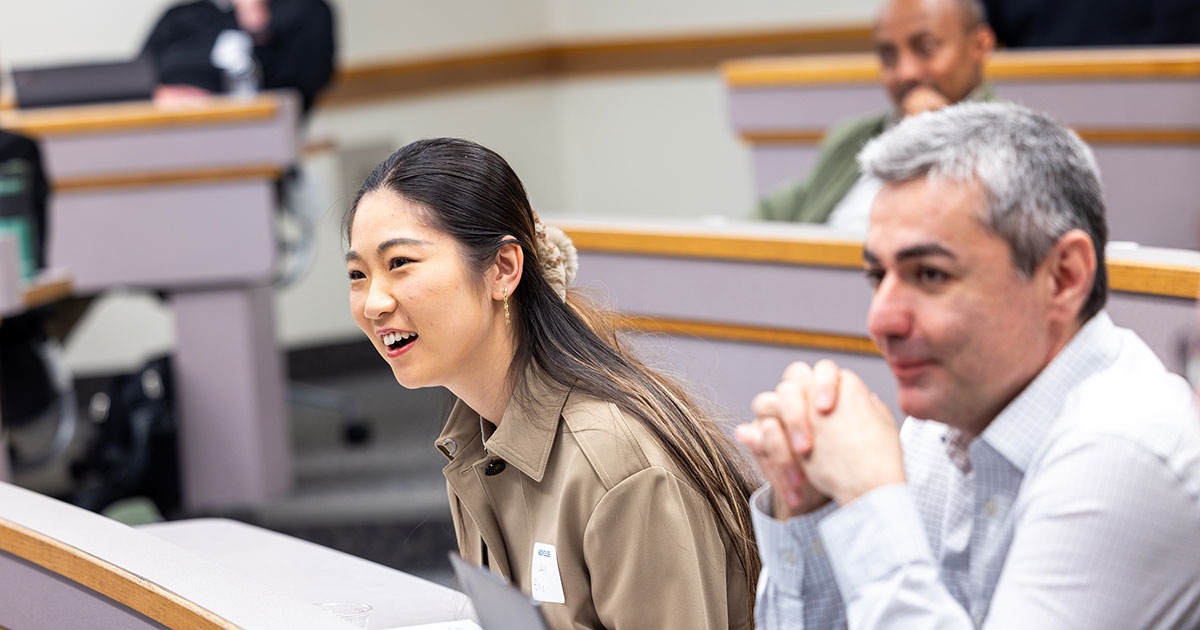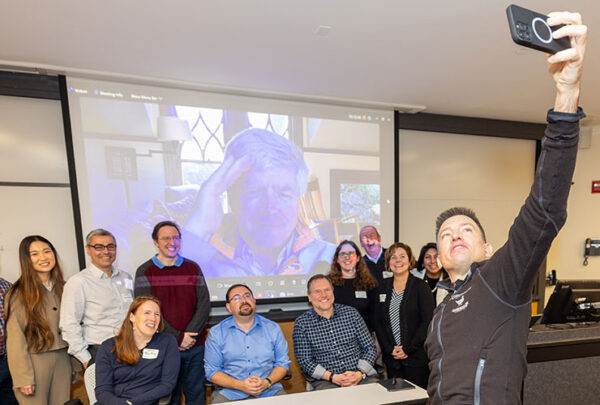Inquiring Minds and Inspiring Research

When digging into data, interviewing subjects, and scouring archives, professors are searching for the hidden truths. They are seeking the unexpected, the surprising, the unknown.
“In research, you look for the aha’s, the counter-intuitive results,” says Patricia Guinan P’17 ’22, associate professor in the Management, as well as the Operations and Information Management, divisions.
Guinan was one of dozens of Babson professors who presented their work at last week’s Faculty Research Day, an annual showcase of the wide range of scholarship happening at the College. Before an audience of their Babson peers, professors discussed research in artificial intelligence, education, entrepreneurship, and a host of other fields.
Guinan talked about her work, conducted with fellow Babson professors Keith Rollag and Alisa Jno-Charles’05, MBA’11, that looked at the dual roles that parents play in a family business. They may be organizational leaders, but they are also moms and dads, and their parenting styles can affect their children’s entrepreneurial behavior.
Would a parent with an authoritarian style, for instance, be more or less likely to cause a child to continue in the family business? What about a permissive style? Whether the next generation is empowered to be entrepreneurial can have a critical impact on the family business’s success and longevity. “How do you keep the next generation going?” Guinan says.
Faculty Research Day was filled with many such intriguing questions. Here are some of the day’s highlights.
Perchance to Dream
One rich area of research on display at Faculty Research Day was tech and AI, with Davit Khachatryan speaking about his students using a web application to analyze something that is universal and surreal: dreams.
“I’m looking for data sets that are one of a kind and fresh in that they are not overanalyzed,” says Khachatryan, an associate professor of statistics. “Everyone dreams. Everyone can connect to it.”

Khachatryan and a former student, DongHyun Chae ’22, created the application, which allows students to access descriptions of dreams posted on Reddit forums. Students choose a type of dream (dreams of cats, dreams of flying) that appeals to them, analyzing it while learning about natural language processing.
The app then allows students to interact with AI technology such as ChatGPT and Dall-E, enabling them to add on to the descriptions of dreams and also make a visual representation of them. Students can create paintings of their selected dreams in the style of Edvard Munch, Gustav Klimt, and other artists.
With their imaginative and whimsical nature, dreams lend themselves to being used as a workshop for AI, Khachatryan said.
A Puzzling Percentage
Peter Cohan found the idea for his research when he came across a percentage that left him puzzled.
It was in an academic article, and it was staggeringly low. In looking at startup founders who had taken initial VC investing, the article stated that only 0.4% of them were able to take their ventures public and remain as CEO a mere three years later.
“Why are so few founders able to run a public company so few years later?” said Cohan, an associate professor of practice in management. “This paper had no explanation.”
Cohan decided to find one, conducting 40 interviews with founders. He discovered what he calls two types of thinking: cognitive lock-in and cognitive hunger.
Leaders with cognitive lock-in, Cohan explained, have a stagnant mindset that isn’t conducive to long-term success. “They stop learning,” he said. “For some reason, this is a common occurrence in leaders. It makes them unable to adapt to a new situation.”
Successful leaders, on the other hand, typically display cognitive hunger, a desire to keep learning and solve new problems. These are leaders who adapt to changing headwinds and invest in new areas of growth. In short, they are built for the long haul. “They have to keep looking forward,” Cohan says.
“In research, you look for the aha’s, the counter-intuitive results.”
Patricia Guinan P’17 ’22, associate professor in the Management, as well as the Operations and Information Management, divisions
Lessons from the Track
Luke Stein likes horse racing. He also likes it as a research topic because the sport is awash with data. “It is interesting and useful as a laboratory because the data is good,” said Stein, an assistant professor of finance.
Insights gleaned from the track also can have implications beyond it. “The lessons we learn from studying horse racing may be useful in understanding other financial markets,” Stein says.
Stein discussed research he performed with Spencer Barnes, a professor at the University of Texas at El Paso, that looks at discrimination in horse betting. Horses, of course, aren’t racialized. The people involved in horse racing, however, are diverse, and some bettors are affected by biases triggered by trainers’ names.
“They make inferences about the quality of horses from the names of trainers,” Stein says. That can result in nonwhite trainers being underestimated and racist gamblers losing more money.
Shining a Light
Elizabeth Swanson P’19 discussed her latest book, The Guantánamo Artwork and Testimony of Moath Al-Alwi: Deaf Walls Speak, which was co-edited with Alexandra S. Moore of Binghamton University.
The book shines a light on Moath Al-Alwi, an artist who has been detained without charge or trial at the Guantánamo Bay detention center since 2002. He is one of 30 men who remain at Guantánamo. “It’s really about bringing this person to life as a human being,” says Swanson, the Joyce H’22 and Andy Mandell ’61 Endowed Professor of Literature and Human Rights.
The book features Al-Alwi’s account of his Guantánamo experiences, as well as his artwork, which includes model ships made of trash from the prison. Art offers Al-Alwi a way to express himself in his confinement.
“The work is a place he could pour everything into,” Swanson says. “It’s a place for him to have control and mastery. It is life-affirming for him.”
Posted in Insights




